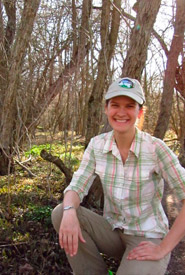Searching for worms in Ontario’s restored tall grass prairie
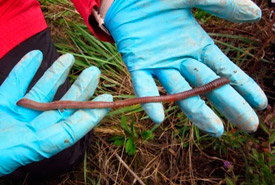
Ontario’s largest exotic earthworm, Lumbricus terrestris. (Photo by Heather Cray)
Looking across a beautiful stretch of native tall grass prairie in its full glory, the first thing that might strike you is, well, the grass; big bluestem, switchgrass, Indian grass, all of them might reach up to or above eye level. Then there are the flowers — hundreds as far as the eye can see. Some are familiar faces, such as brown-eyed Susan and wild bergamot; others are treasured prairie species, such as bush clover, Virginia mountain mint, prairie rose or dense blazing star.
What you’re not likely to observe, or even think about, is what lurks in the ground beneath your feet.
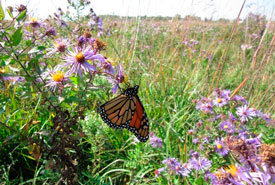
Monarch butterflies are one of the many species at risk that thrive in tall grass habitat. (Photo by Heather Cray)
With only about one per cent of tall grass prairie remaining in Ontario, knowing the components of the ecosystem is key. The Nature Conservancy of Canada (NCC) protects and restores tall grass prairie for the benefit of the dozens of rare and endangered plants, insects, birds and mammals that live there, but we have a new player to consider: earthworms.
Earthworms are a new addition to the prairie. After the glaciers scraped away the soil and took the native worms with them, only two species remained in small, isolated patches. Today, however, Ontario is home to 17 exotic species of earthworm. Originally from Europe, these earthworms likely came over as eggs in soil and full-sized in the dirt packed with trees and crops. Nowadays, they are spread by dumping bait, moving soil long distances and through the horticulture trade.
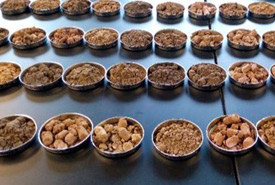
Processing soil samples from clay, loam and sandy restored prairie sites. (Photo by Heather Cray)
Knowing that earthworms eat seeds and seedlings, graze on fungus and root systems of plants and change the soil structure, I was curious: are these exotic invaders living beneath our endangered prairie? As part of my PhD dissertation focusing on tall grass prairie restoration, I wanted to find out.
Equipped with my trusty soil corer, used to draw samples from the ground, wide-brim hat, permission letters, field boots and 44 pounds of mustard water strapped to my back, I set out to sample 22 restored and remnant tall grass prairies across southern Ontario. At each site, I used the mustard water to annoy earthworms up to the surface (they’re not really fans of the condiment). Then I noted the earthworm’s characteristics, recorded the size and density of middens (the surface features of a vertical burrow), and collected a soil sample. Once processed and analyzed in full, this dataset will shed light on the community structure and distribution of exotic earthworms living in our tall grass prairie.
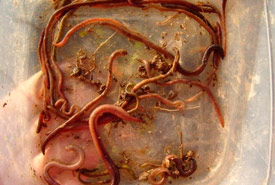
Worm community found in a 20 cm x 20 cm area of soil. (Photo by Heather Cray)
So what happens next? Earthworms are not your typical invasive species. For one thing, there’s no getting rid of them. Living in the soil has its advantages: you would have to poison everything else to get to them, and even then you would likely miss a few. As hermaphrodites, it only takes two individuals to start up a new population all over again. Aside from limiting their spread further, our only option is to get to know our new soil neighbours. What role do they play in the prairie? Do they prefer some seeds to others? Are they helping or harming our restorations efforts, and what can we do about it? Between my lab coat and my field boots, I intend to find out. Until the report is published, all I can tell you is that in some places worm densities are incredibly high, with upwards of 25 worms found in a single 20 cm x 20 cm plot.

